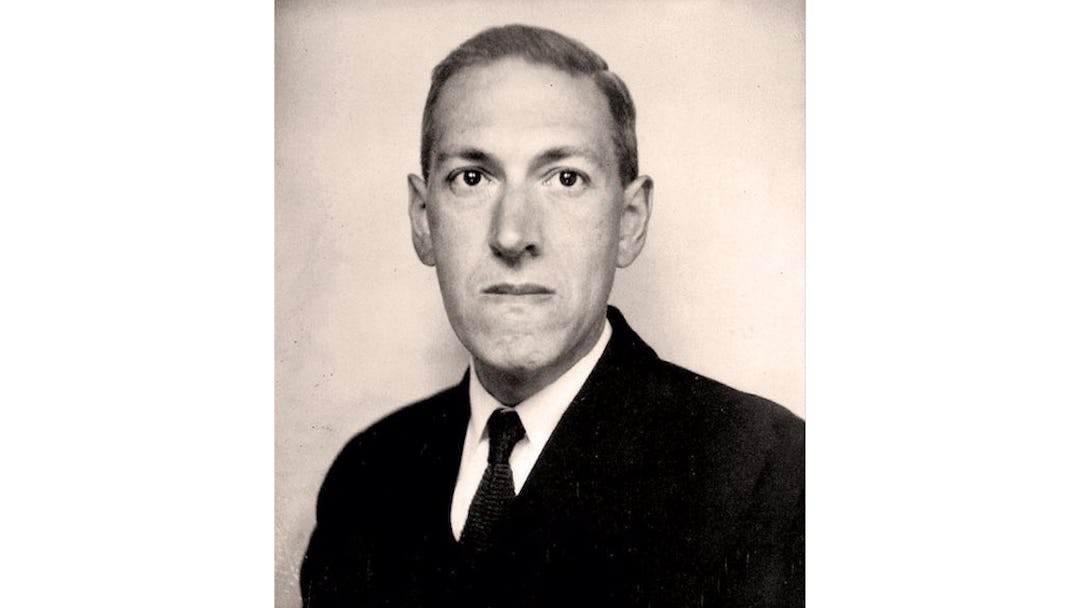Howard Philips Lovecraft was born at home on August 20th, 1890, at 454 Angell Street in Providence, Rhode Island. He was a lanky, lonely child who suffered from a family history of depression, resulting in a nervous breakdown as a teenager. He never completed high school, though he was an incredible autodidact in the years to come, and was able to write some of the most bizarre and enduring “cosmic horror” novels in history that influenced a slew of writers as well as musicians like Mark E. Smith from the Fall and the guys from Rudimentary Peni (unsavory Brits apparently love the stuff). We’ve taken a few of his books from the pile in order to introduce you to the man that Stephen King called “the 20th century’s greatest practitioner of the classic horror tale.” So read on, dear readers, and tell us what Lovecraft novels you love the most.
For Absolute Beginners: The Call of Cthulhu
Here’s the thing: there’s no real place to start–you just have to jump in. However, we think The Call of Cthulhu and Other Weird Stories could be a great place to begin if you’re interested in getting a handle on some of Lovecraft’s more famous short stories. It includes 30 “cosmic horror” tales, including “Herbert West Reanimator,” which was made into countless B-movies. The title story, “The Call of Cthulhu,” was made into a black-and-white silent film a few years ago as homage to the story’s 1926 publication date. You can now watch on Hulu.
For more experienced readers: The Dreams in the Witch House and The Thing on the Doorstep
After you read The Call of Cthulhu, try The Dreams in the Witch House: and Other Weird Stories, which will introduce you to the idea of the Necronomicon (see the glossary on the last page). And no, this isn’t a precursor to the musical genre “witch house.” (Or is it? We’re sure there are arguments to be made on both sides.) Regardless, this book of 20 stories includes “The Shadow Out of Time,” which is an early version of arguably one of Lovecraft’s finest pieces of writing. You can also try The Thing on the Doorstep and Other Stories — another compilation of titles in the short story series which acts as a sequel to The Call of Cthulhu Penguin edition.
Want to read one book instead of three? Try H.P. Lovecraft: Tales
Lovecraft once wrote: “The oldest and strongest emotion of mankind is fear, and the oldest and strongest kind of fear is fear of the unknown.” The Library of America released H.P. Lovecraft: Tales back in 2005, and we couldn’t be happier about it, because it brings his work to a larger audience. This volume includes 22 stories chosen by Peter Straub to represent the best of the “weird fiction” author’s work, so if you’re going to buy anything, you might as well get this collection in order to impress literary nerds who come over to your abode and see that you, too, enjoy the fine look of a Library of America release.
For serious readers: O Fortunate Floridian: H. P. Lovecraft’s Letters to R. H. Barlow
We all now know that Lovecraft wrote horror stories. But how many people have read some of the prolific author’s letters? During his life, he wrote an estimated 100,000 of them to friends, editors, and fans. You can find a list of his letter collections here, or you can pick up O Fortunate Floridian: H. P. Lovecraft’s Letters to R. H. Barlow and read the correspondence between the esteemed author and a devoted high-school fan who was then living in DeLand, a small town near Daytona Beach.
A Brief Glossary of Essential H.P. Lovecraft Terms
C’thulu: A creation of Lovecraft and a favorite of horror/science fiction enthusiasts, C’thulu (pronunciation is interpretive) is described as a kind of demon-god from another world, a monstrosity resembling a gigantic squid or octopus who “sleeps and dreams” in his lair at the bottom of the Arctic ocean, biding his time until some foolhardy “disciples” find means to call him to rise and reclaim dominion of the earth. Doubtlessly, some are actually trying! (From The Atlantic Paranormal Society’s website.)
Mythos: The term for the body of work created and inspired by the writings of H.P. Lovecraft and others. The original term Cthulhu Mythos has been recently shunned by Lovecraftian scholars, since the body of work is greater than a mere collection of stories about Lovecraft’s horrific entity known as Cthulhu. (From the green-speckled website of the Lair of the Mythos Haiku.)
Necronomicon: A grimoire (that is, collection) of ancient sigils and incantations of nebulous origins, discovered in the eighth century by the “Mad Arab,” Abdul Alhazred, said to be capable of opening a chasm to the “Dread Dimension” and unleashing the wrathful power of the timeless “Elder Gods.” Although some occultists believe this tome to be at least derived from genuine (and nefarious) sources, we are fairly confident that it sprang from the fiction of Providence, Rhode Island-born horror author, Howard Phillips (H.P.) Lovecraft (b. 1890, d. 1937). (From The Atlantic Paranormal Society’s website.)
If you’re looking for a list of characters in Lovecraft’s work, then try this site.
